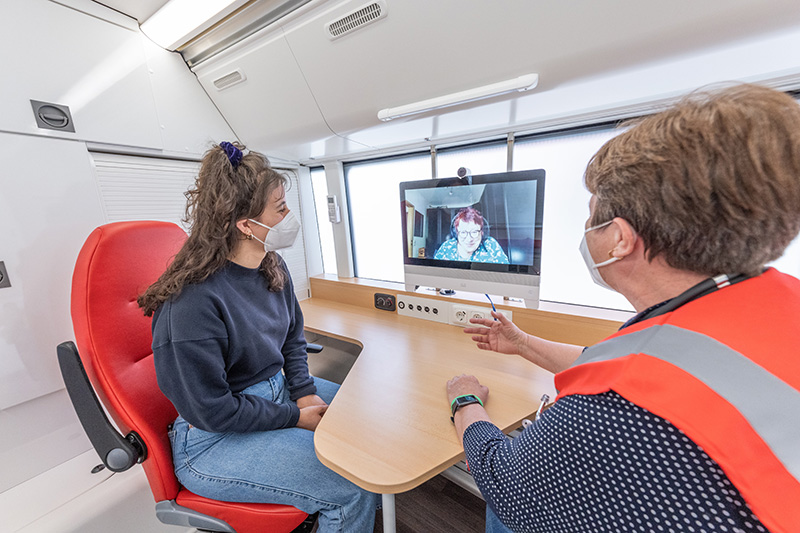Deutsche Bahn’s DB Medibus Solution Mobilizes Healthcare in Times of Crisis
Cisco
Over the past decade in Germany, we saw young people moving from rural areas to cities, leaving elderly residents stuck in increasingly empty small towns without health resources. But the pandemic brought about another shift: the growth of remote work and city housing costs has led to a revived interest in moving out to the countryside. Still, there’s a huge lack of infrastructure.
Since Deutsche Bahn is in the business of connecting people, it made sense for us to step in.
Deutsche Bahn is the second-largest transport-related company, and the largest rail infrastructure owner in Europe with more than 330,000 employees around the world. Our role of connecting people meant we were one of the first to notice the extent of the demographic problem.
We figured we could accommodate aged homeowners and young families alike with a doctor's office on wheels.
The Impact of the DB Medibus
We created the DB Medibus, and launched the project with Charité, a Berlin Hospital that used the mobile clinic to provide vaccinations and treat refugees in facilities throughout the city. We enhanced the clinic by partnering with Cisco to implement the IT foundations and Webex collaboration devices needed to provide translations via teleconferencing. Finally, refugees could talk with a doctor in their native language.

We continued the project by providing recommended immunizations to school children throughout Germany. The German Ministry of Health even launched a major vaccination campaign using one of our DB Medibuses. Cisco's partnership was incredibly vital during this stage because of the need for a constant, reliable internet connection through rural areas.
DB Medibuses were soon traveling regular routes throughout Germany. By keeping consistent staff and travel schedules, doctors serve remote communities without opening an isolated practice, and they also establish relationships and build trust with their patients. It wasn’t always easy, though. One Medibus pilot project received a lot of protests because people didn’t want a mobile doctor. But the Medibus came, and the doctor offered consistent, personal service for weeks on end. At the end of the pilot, people protested again—this time, demanding the Medibus route become permanent. Now, it’s a regular service.
In addition to personal health benefits, there are community benefits. Rather than everyone driving cars to the nearest metropolitan area to see the doctor or shop, they have a reason to connect with each other locally while going to the Medibus. It’s revived a sense of community.
And surprisingly, it’s connected politicians. Members on both sides of the political spectrum united in support for our concept and passed a law ordering the use of mobile medical offices in rural areas under-supplied by doctors.
Responding to Global Emergencies and Crises
During the pandemic, the DB Medibuses enabled and mobilized Robert Koch Institute (RKI) researchers to conduct COVID-19 antibody studies on more than 10,000 citizens, and the Webex devices provided real-time translation services to non-German speakers.
That wouldn’t be the last emergency use for DB Medibuses. When Russia invaded Ukraine in February 2022, many Ukrainian refugees came to Germany. Cisco suggested the DB Medibus fleet could be of immediate use, and we launched medibushelps.org, an initiative to improve basic medical care for refugees.
With the support of Cisco’s Country Digitization Acceleration program, we rapidly deployed four DB Medibuses to support Ukrainian refugees into German urban centers s.a. Hamburg, Cologne, and Berlin, where existing medical services were overwhelmed. Mobile medical professionals offered vaccinations and other medical care to refugees from all countries on these Medibuses until the end of January 2023. DB Medibuses drove 11,589 kms to 518 refugee settlements, treating more than 12,000 patients with the program. The translation system was again the big game changer, operating more than 220 hours and bridging the language gap between doctors and patients from abroad. We’re working to make the service permanent in Berlin, where many refugees continue to arrive.
Medibuses are very efficient in disaster zones because the vehicles are fully self-contained. In addition to transporting medical staff and equipment, a DB Medibus has 16 solar panels to create its own electricity and operate in areas cut off from all infrastructure. We have a Starlink antenna that we can connect via satellite to bring in remote interpreters through the Cisco monitors if necessary. This all puts doctors in a situation where they can complete a life analysis and administer proper care.
A Sustainable Path Forward
Big changes must happen for us to live sustainably on Earth, and one of these will be our mobility behavior. Mobile infrastructure brings infrastructure closer to people, so they don’t engage in individual motorized mobility. We also must serve rural populations better with public transportation, possibly rejuvenating train tracks that have been out of service for years. All of this requires a collective effort, and the DB Medibus is just one of many ideas of mobilizing infrastructure. We can mobilize dentists, pharmacies, town halls, and we are even launching our first supermarket bus.
Technology is omnipresent for this project. While the average doctor's office in rural Germany runs on a Windows 95 PC, the DB Medibus is like landing a spaceship. It's bright, it's inviting, and it's full of high-tech equipment. People can be greeted with a monitor using interpreters, and general practitioners can bring in specialists to offer a higher level of medical care. The bus is a bridge in itself, but the technology aboard makes the bridge possible.
Deutsche Bahn is a public transportation company, and we’re very good at what we do. But we rely on our partners to build that bridge from specialist services to our buses, and that's where Cisco helps. The DB Medibus may seem like “just” a mobile doctor's office, but it’s had a big impact on rural communities and become an impactful way to approach crisis intervention and address humanitarian needs.







